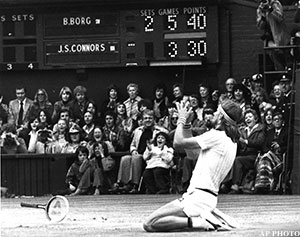
15-Love. Why 15? Why Love?
In 20 years of playing tennis, these are questions I never thought to ask until my wife, who's never played a game of tennis in her life, wondered aloud, "What's the deal with the wacky scoring system in tennis?"
So I started asking questions, and here's what I found out:
No one really knows the exact derivation of the scoring system, though there are two prevailing theories. To fully understand them, it helps to know the roots of the game, which aren't always entirely clear, either.
Tennis dates back to the 12th century when the French played jeu de paume -- "game of palm." Racquets were added around the 16th century, and an Englishman named Major Walter C. Wingfield patented the sport in 1874, unveiling it to the people of Wimbledon three years later.
(As an aside, the term "tennis" is thought to come from the French word "tendre" meaning "to hold," though there is no consensus on this or any other theory.)
From the beginning, the scoring has always been in increments of 15. Why? One theory points to the hands on a clock. Four points make up a complete game, so 15, 30, 45 and 60 make up an entire rotation.
While it's a nice theory, it still doesn't answer the question, Why?
For further explanation, we turned to the "United States Tennis Association Official Encyclopedia of Tennis," edited by Bill Shannon:

"Several theories as to why this happened have been advanced over the years, but the soundest one appears to have a relation to the sextant of astronomy. The sextant is sixty degrees, or one-sixth of a circle. In early records of the game in France, sets were played to four games. Since sixty degrees make a full circle when multiplied by six, it is thought that matches were six sets of four games each. Therefore, each point was worth fifteen degrees, or points, contributing to the whole. The game concluded when one player completed a full circle of 360 degrees."
But if everything is measured in degrees of 15, why does the scoring go from 15 to 30 to 40? What happened to 45?
Bud Collins, tennis historian, broadcaster and screamer of the phrase "net cord," concludes that it's simply an abbreviation; that somewhere along the way players tired of the extra syllable and simply shortened 45 to 40, much the way current players have taken to using 5 instead of 15.
Of course, we can't forget about "Love" and "Deuce," both of which can find their derivation using a French-to-English dictionary. "Love," the prevailing theory goes, has its origins from the French word l'oeuf, which means egg. (Get it? Egg. Zero.) Deuce comes from à deux, or "two" points needed to win the game.
There have been several campaigns over the years to simplify the scoring system to a 1-2-3-4 format, but they have always been rebuffed.
One of those pushes came in 1919 when the game had a bit of an image problem, no thanks, apparently, to the term "Love." According to an article that appeared in the New York Times on July 27, 1919:
"They argue that this absurd bit of terminology has been the chief reason for the charge of effeminacy which for years has been held against tennis, and they are probably right."
In other words, using "Love" as a scoring term made the game effeminate or "not manly."
Again, from the New York Times:
Despite this very persuasive argument, seven months later the United States Lawn Tennis Association, as it was known then, voted against the proposed change.
Which is why Love lives on.




